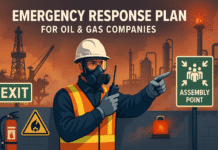
Hazardous Atmosphere Monitoring: Safeguarding with Gas Detection and Alarms
Introduction
In industries where hazardous substances are present, monitoring the atmosphere for potential threats is paramount for the safety of workers and the environment. This article explores the crucial aspects of hazardous atmosphere monitoring, focusing on the significance of gas detection systems and alarms in preventing and responding to potential dangers.
Understanding Hazardous Atmospheres
- Definition of Hazardous Atmosphere
- Presence of Harmful Substances: A hazardous atmosphere contains substances in concentrations that pose a threat to health, safety, or the environment.
- Types of Hazards: Hazards may include flammable gases, toxic chemicals, or oxygen-deficient environments.
- Potential Sources of Hazards
- Industrial Processes: Hazardous atmospheres can result from various industrial processes, such as chemical manufacturing, confined space work, or storage of volatile materials.
- Accidental Releases: Unintended releases of gases or vapors can also contribute to the formation of hazardous atmospheres.
The Role of Gas Detection Systems
- Early Detection of Hazardous Gases
- Continuous Monitoring: Gas detection systems provide continuous monitoring of the air, offering real-time data on the presence and concentration of harmful gases.
- Immediate Alerts: Early detection allows for immediate alerts, enabling timely evacuation or intervention to prevent potential disasters.
- Types of Gas Detection Technologies
- Fixed Gas Detectors: Installed in specific locations, these detectors continuously monitor the air for targeted gases and provide localized alarms.
- Portable Gas Detectors: Worn by workers, these devices offer personal monitoring in dynamic work environments, ensuring individual safety.
- Multi-Gas Detection Capabilities
- Versatility: Many modern gas detection systems can monitor multiple gases simultaneously, addressing the complexity of diverse industrial settings.
- Customizable Configurations: Users can customize configurations to detect specific gases relevant to their operations.
Alarm Systems: Prompting Action in Critical Situations
- Audible and Visual Alarms
- Auditory Warnings: Audible alarms provide immediate alerts even in noisy environments, signaling the presence of hazardous gases.
- Visual Indicators: Visual alarms, such as flashing lights or color-coded displays, enhance awareness and visibility of potential dangers.
- Integration with Automation Systems
- Seamless Integration: Gas detection alarms can be integrated with automation systems to initiate automatic shutdowns or other safety protocols.
- Enhanced Response Time: Automation ensures rapid response times, reducing the potential impact of hazardous events.
- Remote Monitoring and Notifications
- Real-time Notifications: Remote monitoring capabilities enable stakeholders to receive real-time notifications of gas detection events.
- Mobile Alerts: Mobile notifications allow for immediate response, even if personnel are not physically present at the monitored site.
Maintenance and Calibration Practices
- Regular Calibration Checks
- Accuracy Assurance: Regular calibration checks ensure the accuracy of gas detection equipment, preventing false alarms or undetected gas presence.
- Compliance Requirements: Adherence to regulatory standards often mandates scheduled calibration practices.
- Periodic Maintenance and Sensor Replacement
- Sensor Integrity: Periodic maintenance, including sensor checks and replacements, ensures the ongoing reliability of gas detection systems.
- Preventive Measures: Proactive maintenance prevents system failures and ensures continuous protection against hazardous atmospheres.
Creating a Culture of Safety
- Training and Education
- User Training: Provide comprehensive training for personnel on the proper use and interpretation of gas detection equipment.
- Emergency Response Drills: Conduct regular drills to familiarize workers with emergency procedures triggered by gas detection alarms.
- Documentation and Record-Keeping
- Maintaining Records: Keep detailed records of gas detection data, calibration activities, and maintenance schedules.
- Audit Trails: Comprehensive documentation facilitates audits and ensures compliance with safety regulations.
Conclusion
Hazardous atmosphere monitoring, facilitated by advanced gas detection systems and alarms, is indispensable for ensuring the safety of workers and mitigating environmental risks. Through the implementation of cutting-edge technologies, integration with alarm systems, meticulous maintenance practices, and a commitment to creating a culture of safety through training and documentation, industries can navigate their operations with heightened awareness and responsiveness to potential dangers.
Root Cause Analysis Tools in Six Sigma
Process of Root Cause Analysis
7 Different Root Cause Analysis Techniques
Frequently Asked Questions (FAQs)
- What is a hazardous atmosphere?
- A hazardous atmosphere contains substances in concentrations that pose a threat to health, safety, or the environment. These may include flammable gases, toxic chemicals, or oxygen-deficient environments.
- How do gas detection systems contribute to safety?
- Gas detection systems provide continuous monitoring of the air for hazardous gases, enabling early detection and immediate alerts. They play a crucial role in preventing potential disasters and ensuring the safety of workers.
- What are the types of gas detection technologies?
- Gas detection technologies include fixed gas detectors, which are installed in specific locations for continuous monitoring, and portable gas detectors, worn by workers for personal monitoring in dynamic environments.
- Why are audible and visual alarms important in gas detection systems?
- Audible alarms provide immediate alerts, especially in noisy environments, while visual alarms enhance awareness through features like flashing lights or color-coded displays. Both contribute to prompt action in critical situations.
- What is the importance of maintenance and calibration in gas detection systems?
- Regular maintenance and calibration checks ensure the accuracy and reliability of gas detection systems. This prevents false alarms or undetected gas presence, contributing to the overall effectiveness of safety measures.
























